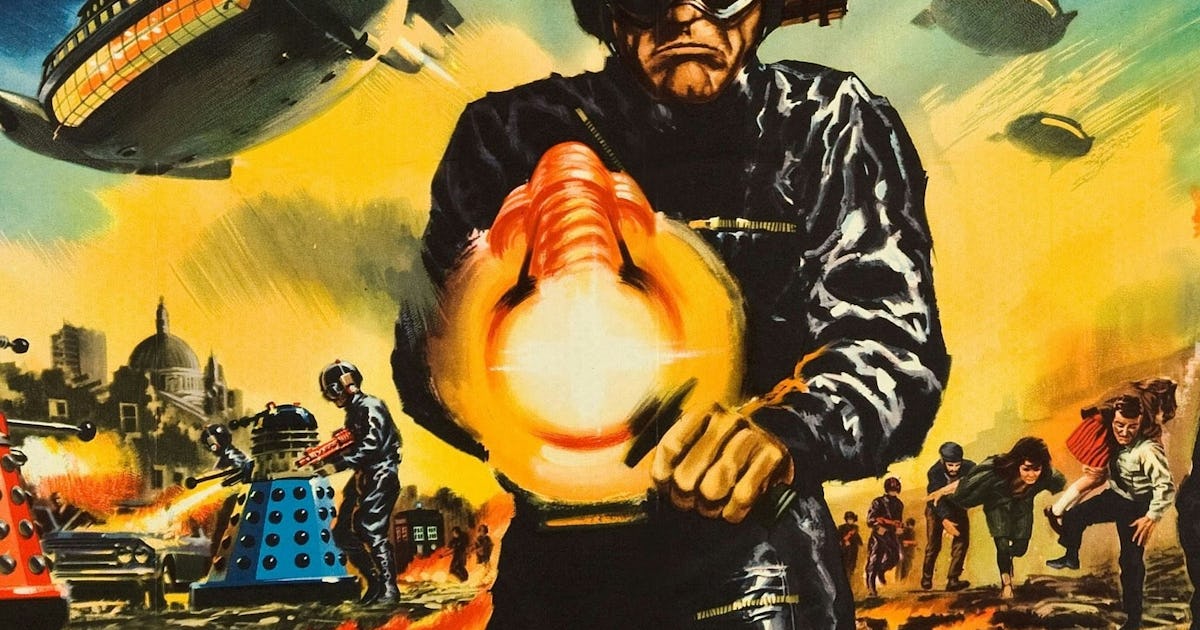Fans of older science fiction films have never had it better, at least when it comes to the return of forgotten gems of the genre. And, for those who are laser-focused on sci-fi classics that are both obscure and paradoxically very famous, you can do no better than the recent restoration of Dr. Who and the Daleks and Daleks’ Invasion Earth 2150 A.D.
Both enjoyed home video rereleases in 2020 and 2022, but the latest Severin 2025 release of these two movies is gorgeous, fascinating, and utterly essential for discerning sci-fi fans. These two quirky Who movies may have caused debates for decades, but today, they each hold up surprisingly well. And maybe not for the reasons you’d expect.
The Strange History of the Peter Cushing Dr. Who Movies
If you’re fuzzy on why there were two non-canon Doctor Who movies in 1965 and 1966 — in which the character was called “Dr. Who” rather than “the Doctor” — here’s the basics: The concept of the Daleks, designed by Raymond Cusick, and written by Terry Nation, first appeared in the second serial of Doctor Who, the 1963 story which began with the episode called “The Dead Planet.” Nearly overnight, “Dalekmania” swept the U.K., with the visage of the strange mutant robots becoming a short-lived craze. Because Nation was able to secure the rights to the Daleks and his scripts for Who, he was legally able to use those stories in a completely different format. And so, in 1965, while William Hartnell was still the 1st Doctor on TV, an alternate, much bigger-budget version of the Daleks and the Doctor hit the big screen; Dr. Who and the Daleks, which was followed by a 1966 sequel, Daleks’ Invasion Earth 2150 A.D.
Essentially, and very clearly, a separate continuity from the series, these films reimagine the titular Time Lord as a cooky human inventor, played charmingly by a pre-Star Wars Peter Cushing, who, at only 51 years old, is playing much older than he is. Cushing delivers a kind of sunnier homage to the cranky grandfather Doctor of Hartnell’s TV version of the character, which doesn’t always work, but today, feels like an alter-ego the Doctor might project into the past as a kind of propaganda. (Steven Moffat later made these films pseudo-canonical in his novelization of The Day of the Doctor.)
In terms of franchises with competing versions, perhaps the best analogy is the 1983 Sean Connery film Never Say Never Again, an unofficial James Bond film that was a remake of Thunderball, and was pitted against the “official” Bond film of the same year, Octopussy. The difference, of course, is that most Bond fans have seen Never Say Never Again, while it’s very reasonable to say that a vanishingly small number of Doctor Who fans born after, say, 1980, have committed either of the Cushing Who films to memory. American Who fans, and those who came to the series since 2005, are even less likely to be familiar with these movies, especially considering the non-canonical status of both.
Why Are the Peter Cushing Dr. Who Movies Important to See Now?
A 1965 movie poster for Dr. Who and the Daleks.
LMPC/LMPC/Getty Images
Both Dr. Who and the Daleks and Daleks’ Invasion Earth 2150 A.D. are worthwhile, if not as movies themselves, but as pop culture artifacts. In 1965 and 1966, there was not yet a Planet of the Apes or 2001: A Space Odyssey. The two Dr. Who Dalek movies represent a kind of pre-dawn of serious science fiction movies, in which noted source material (the Doctor Who TV series) was spun into big-screen adventures designed to attract a wide audience. In reality, this gambit was only partially successful, but the legacy of these films is very much with the Who franchise today, and, in a sense, filmed sci-fi more broadly.
On one of the newer commentary tracks, Mark Gatiss refers to Daleks’ Invasion Earth 2150 A.D. as a kind of sci-fi “exploitation” film, insofar as the movie freely borrows from the Who TV series, but tries to remix it into something both slicker and more garish simultaneously. Hints of contemporary Who are seen throughout this considerably darker second film, and the French resistance feeling of humans fighting against Daleks will remind very mainstream Star Wars fans of the vibes of Andor Season 2.
What New Features Does the Total Extermination: The Peter Cushing Doctor Who Collection Have?
The brand-new 2025 Severin repackaging of Cushing’s two Who films, Total Extermination: The Peter Cushing Doctor Who Collection, is the best deal for owning these movies on Blu-ray, DVD or 4K. And the extensive special features feel like a full college-level course, not just in these specific movies, but Doctor Who’s history more broadly. Of all the commentary tracks, the 2020 commentaries from Who expert Kim Newman, writer of the 2005 episode “Dalek,” Robert Shearman, and beloved Who actor/writer Mark Gatiss are the most delightful and informative.
In these commentaries and various documentaries, the entire genesis of these Dalek films is fully unpacked, along with little tidbits of trivia, such as the fact that Ridley Scott was originally commissioned to design the Daleks in 1963 before Raymond Cusick took over. There’s also good discussions about how Cushing’s Who films connected to a lost generation of sci-fi fans, people who could not watch TV episodes on repeat, and craved seeing bigger sci-fi adventures in the cinema.
Both time capsule and alternate universe, the newest set of Cushing Who films is utterly beautiful and equally entertaining. This may not be the best Doctor Who of all time, but it is certainly the least talked about, and therefore, the most interesting.
Total Extermination: The Peter Cushing Doctor Who Collection is available to purchase on 4K Blu-ray now.
Source link
Movies,TV Shows,Science Fiction,movies,science-fiction,doctor-who,entertainment,inverse-recommends-movies,homepage,hp-latest,adex-light-bid,blu-ray



Average Rating